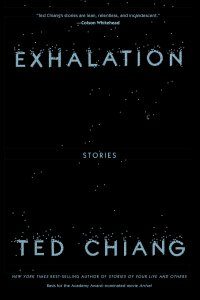Short Fiction in Print, 2019 by Rich Horton

My remit here at Locus is primarily to cover short fiction from print sources, and thus I thought to build my year end summary around just that. But don’t forget – there is a great deal of excellent work that appears first online. To that I will add my usual plea – don’t ignore the print work just because it’s harder to find.
I’ll begin with two collections that got a great deal of notice outside the SF field. One is Orange World, by Karen Russell, the other is Ted Chiang’s Exhalation. The latter made the New York Times list of the 10 best books of the year, and was praised by Barack Obama among almost everyone else. There were two originals, both excellent – my favorite being “Omphalos”, which examines a universe in which Young Earth Creationism is true, and has been proven scientifically. But a scientist makes a discovery that quite changes the implications of that. Exhilarating work. As for Orange World, I’ll mention that I liked the title story enough to enquire about using it in my Best of the Year anthology (she declined, in deference to the collection.) There’s one new story in this book, “The Gondoliers”, a very fine near-future SF (or “cli-fi”) story, about a young woman who steers a gondola through the waters that have taken over southern Florida. We learn a little about the catastrophe, from a passenger who remembers the old times, and hints of the new world, particularly the ways this woman and her sisters have adapted.
“The Gondoliers” was also published in the final issue of Tin House, which was a literary magazine noticeably sympathetic to the fantastic. That same issue also included an exceptional Kelly Link story, “The Girl Who Did Not Know Fear”, about an academic stranded in Detroit, missing her wife and daughter, which seems mundane enough except, it’s Kelly Link, and it’s still strange (and homey!) and we are not told but subtly shown that this world is not quite ours. Maybe.
Another striking collection came from L. Timmel Duchamp’s wonderful feminist small press Aqueduct: Sofie Rhei’s Everything is Made of Letters. Rhei is a Spanish writer, and this book features five strong stories, all as far as I know appearing in English for the first time. The title of the collection betrays the uniting theme: an interest in language, and in stories, and in translation. My favorites were “Secret Stories of Doors”, about a man in an oppressively alternate history sneaking false stories into the encyclopedia, and “Learning Report”, about a woman on another planet trying to learn the alien language – with the help of a toy that eventually claims to be yet another alien. An excellent book, presenting a quite different voice, often funny, often just weird, in a thoughtful way.
 Three original anthologies that stuck out for me were Jonathan Strahan’s Mission Critical, Nisi Shawl’s New Suns, and Cat Rambo’s If This Goes On. The latter book is very uneven, but it does include one of the very best stories of 2019: “Green Glass: A Love Story” by E. Lily Yu, a wickedly satirical look at an environmentally ruined future and an even more class-stratified society. Yu also contributed a strong story to New Suns, “Three Variations on a Theme of Imperial Attire”, which has three very dark takes on the Emperor’s New Clothes. (She had a tremendous year in short fiction, with very good stories in Asimov’s, Lightspeed, and at Tor.com as well.) Other exceptional stories in New Suns include Minsoo Kang’s “The Virtue of Unfaithful Translations”, which tells of two obscure people, translators for implacable foes, who (perhaps?) save their polities much pain by their efforts – though the question of unfaithful translations also informs an effective afterstory; and Chinelo Onwualu’s “The Fine Print”, SF that uses fantasy tropes, as a man must pay back a “Djinn” with his “firstborn son” for the Djinn’s help in finding him a wife – and then refuses, with unexpected consequences.
Three original anthologies that stuck out for me were Jonathan Strahan’s Mission Critical, Nisi Shawl’s New Suns, and Cat Rambo’s If This Goes On. The latter book is very uneven, but it does include one of the very best stories of 2019: “Green Glass: A Love Story” by E. Lily Yu, a wickedly satirical look at an environmentally ruined future and an even more class-stratified society. Yu also contributed a strong story to New Suns, “Three Variations on a Theme of Imperial Attire”, which has three very dark takes on the Emperor’s New Clothes. (She had a tremendous year in short fiction, with very good stories in Asimov’s, Lightspeed, and at Tor.com as well.) Other exceptional stories in New Suns include Minsoo Kang’s “The Virtue of Unfaithful Translations”, which tells of two obscure people, translators for implacable foes, who (perhaps?) save their polities much pain by their efforts – though the question of unfaithful translations also informs an effective afterstory; and Chinelo Onwualu’s “The Fine Print”, SF that uses fantasy tropes, as a man must pay back a “Djinn” with his “firstborn son” for the Djinn’s help in finding him a wife – and then refuses, with unexpected consequences.
Mission Critical features stories about characters in desperate situations, the best being “Hanging Gardens” by Gregory Feeley and “Cyclopterus” by Peter Watts. Feeley’s story is set on Mars and concerns the surviving children trekking (with an AI’s ambiguous help) to rescue by the orbital “Hanging Gardens” after a terraforming mishap destroys their home. Watts’s is more cli-fi, and terribly dark, as we might expect from him – with two people trapped in a deepwater submarine after some sort of underwater wave destroys their refuge: this is a future Earth already destroyed, and even hoped for safety under the ocean is illusory.
Every year many of the best novellas come from for Tor.com. I haven’t caught up with all of them yet, but those I did really like include C.S.E. Cooney’s Desdemona and the Deep, in which the title rich girl begins to recognize her industrialist father’s crimes, and goes to the “underworld” with her best friend, where both of them realize something of their true nature. The plot is hectic, and drags just a bit in places, but there is always the music of Cooney’s prose, and the comic coloration, and the engaging and just awakening Desdemona to keep us entranced. Also, Greg Egan’s Perihelion Summer, another example of cli-fi (unavoidable these days, and it should be unavoidable, as we learn with each new crisis, most obviously, as I write, the wildfires in Egan’s own country, Australia). In this long novella a black hole intensifies the crisis, and the story follows attempts to ride out the disaster on a self-sufficient “floating island.” Plenty of sharp speculation, resembling Kim Stanley Robinson but less optimistic.
 I’ll continue to the magazines. At Asimov’s, I was particularly impressed by Michael Swanwick’s “Cloud”, with a theme a bit reminiscent of E. Lily Yu’s “Green Glass”, as a man encounters his fiancée’s intimidating super rich family, and the combined metaphor/reality of the Cloud they inhabit. Ray Nayler, truly one of the up-and-coming masters of SF short fiction, had multiple fine stories out in 2019, not only in Asimov’s but in Clarkesworld and Lightspeed, and my favorite was “The Ocean Between the Leaves”, about a woman, a gardener for a privileged Istanbul family, who falls into a coma, leading by accident to an odd relationship between her estranged brother and one of her nurses. But… that’s not really what’s going on, as we learn in this subtle piece. Rammel Chan’s “Tourists” is a slickly executed piece about a “tourist” – an alien visitor pretending to be human, who encounters some other apparent tourists, leading to a scary revelation.
I’ll continue to the magazines. At Asimov’s, I was particularly impressed by Michael Swanwick’s “Cloud”, with a theme a bit reminiscent of E. Lily Yu’s “Green Glass”, as a man encounters his fiancée’s intimidating super rich family, and the combined metaphor/reality of the Cloud they inhabit. Ray Nayler, truly one of the up-and-coming masters of SF short fiction, had multiple fine stories out in 2019, not only in Asimov’s but in Clarkesworld and Lightspeed, and my favorite was “The Ocean Between the Leaves”, about a woman, a gardener for a privileged Istanbul family, who falls into a coma, leading by accident to an odd relationship between her estranged brother and one of her nurses. But… that’s not really what’s going on, as we learn in this subtle piece. Rammel Chan’s “Tourists” is a slickly executed piece about a “tourist” – an alien visitor pretending to be human, who encounters some other apparent tourists, leading to a scary revelation.
The best story of 2019 in Analog was Alec Nevala-Lee’s “At the Fall”, sort of a robot “Incredible Journey” about a self-aware deep-ocean hydrothermal vent exploration machine which tries to make her way home all the while wondering why she can never detect radio signals from humans. Egan is here too, with “The Slipway”, one of his intricate explorations of a scientific mystery, as an astronomer tries to understand the nature of an object that suddenly appears in the sky, offering sort of a window to a distant galaxy. I also really liked Adam Troy-Castro’s “The Savannah Problem”, probably my favorite (so far) of his Draiken stories, in which Castro depicts Draiken’s pursuit, capture, and extraction of a gangster thug from a space station, leading to a brilliant and rapid thematically relevant conclusion. (Castro is another writer, like Nayler and Yu, who had several strong stories this year, including work in F&SF and Lightspeed. For that matter, so did Egan, with good work in Asimov’s and Tor.com as well as the stories mentioned above.)
I think F&SF had a very strong year. Rich Larson’s “Contagion’s Eve at the House Noctambulous” is a very dark story, uncompromising in its portrayal of a wholly awful society composed of genetically altered survivors of an apocalypse and a plague, who enslave those humans who survived without alteration. Cassandra Khaw’s “Mighty are the Meek and the Myriad” is very impressive, a curious mixture of satire of the different pretensions of a couple of humans after a human/robot war, comic interludes with the robots, and some really effecting passages, leading to a dark conclusion. Tonally mixed, in a way hard to pull off, managed very well by Khaw.
Lavie Tidhar’s “New Atlantis” tells of a fantastical journey to a sort of sunken island among an ecologically motivated future civilization in the midst of a sort of post -apocalyptic world. There are various malevolent machines (and a giant robot!), a hidden virtual society, and fun allusions to the Arthurian cycle, to Heinlein, to Auden, and even to Alan Garner. Debbie Urbanski’s “How to Kiss a Hojacki” is impressive and disturbing, about a man whose wife (with many other women) has mysteriously changed into a “Wonderful” person – unspeaking, physically altered, uninterested in sex. The political implications are obvious, and the personal implications as well (perhaps needless to say, the personal effects on the protagonist are not great). And one of the best stories of the year is surely Sam J. Miller’s “Shucked”, a first-rate horror story in which a woman is approached by an older man who wants her permission (for money) to spend time with her boyfriend. This is an example of a writer using a fairly familiar idea (which I won’t spoil) so artfully that it becomes newly effective.
 My favorite Interzone story was John Kessel’s “Fix That House!”, a sly and savage story about a couple rehabbing a 19th-Century Southern mansion authentically. The demands of true authenticity are strict! You probably see where this is going, and Kessel takes us there viciously.
My favorite Interzone story was John Kessel’s “Fix That House!”, a sly and savage story about a couple rehabbing a 19th-Century Southern mansion authentically. The demands of true authenticity are strict! You probably see where this is going, and Kessel takes us there viciously.
Among smaller magazines, I saw a really fine story in On Spec, “Mnemosyne” by Catherine MacLeod, about a sort of ghost-catcher who is engaged to deal with the ghost of her former lover. We learn in flashbacks something of their history and the reasons she has been hired. The story snaps shut quite delightfully.
The weird little magazine Bourbon Penn continued to feature neat stuff, best perhaps “The Immaterialists” by Charles Wilkinson, about a graduate student investigating the weird poets published by a certain Eyam Editions, whose books of poems and plays seem impossible to find.
At Not One of Us, Alexandra Seidel’s “Bark, Blood, and Sacrifice” is an effectively mysterious story about a strange house, and a girl named Labyrinth, her brother and two fathers and incest and Inanna and gates. It’s just odd, otherworldly, hard to describe, and powerful.
Of course Lady Churchill’s Rosebud Wristlet remains a towering figure in the world of tiny-press magazines. This year my favorite story was Frances Rowat’s “Ink, and Breath, and Spring”, a lovely, mysterious, and sad mystery story, about a murdered and flensed man found in the gardens of a strange library, and the way a groundskeeper somewhat unwillingly finds out what happened.
There is one online magazine I cover regularly – perennial Hugo winner Uncanny. Excellent work this year included Sarah Pinsker’s “The Blur in the Corner of Your Eye”, effective SF/horror about Zanna, a successful mystery writer, who while trying to finish her latest book stumbles onto an apparent murder – and we end up learning something really cool and scary. Maurice Broaddus’s “The Migration Suite: A Study in C Sharp Minor” reimagines the African diaspora, from migrations in ancient Africa to the forced migration of slaves to America, to the escape to the North, followed by the post-Civil War moves to Northern cities, extending even to the Moon and the stars.
Fran Wilde’s “A Catalog of Storms” concerns the stress between the heroic life and the mundane, and also language and letting go, as a family in a seaside village apparently protected from storms by their transformed children deals with further losses. And Marie Brennan’s “Vīs Dēlendī”, is a lovely, dark story set at a magical school, as a young man attempts to bring a fellow student, killed in an accident, back to life. The story comes to a fully believable and somewhat wry conclusion.
I do want to emphasize that this look at the print sources certainly misses some outstanding stuff that appeared online – Karen and Jonathan will doubtless highlight what I’ve missed in their essays!
Rich Horton works for a major aerospace company in St. Louis MO. He has published over a dozen anthologies, including the yearly series The Year’s Best Science Fiction and Fantasy from Prime Books, and he is the Reprint Editor for Lightspeed Magazine. He contributes articles and reviews on SF and SF history to numerous publications.
This review and more like it in the February 2020 issue of Locus.
 While you are here, please take a moment to support Locus with a one-time or recurring donation. We rely on reader donations to keep the magazine and site going, and would like to keep the site paywall free, but WE NEED YOUR FINANCIAL SUPPORT to continue quality coverage of the science fiction and fantasy field.
While you are here, please take a moment to support Locus with a one-time or recurring donation. We rely on reader donations to keep the magazine and site going, and would like to keep the site paywall free, but WE NEED YOUR FINANCIAL SUPPORT to continue quality coverage of the science fiction and fantasy field.







